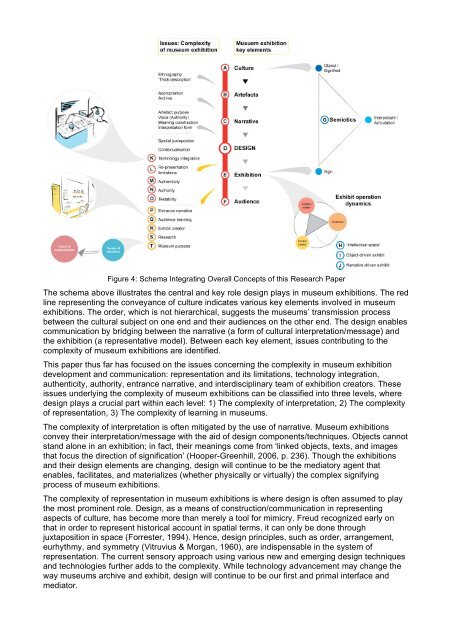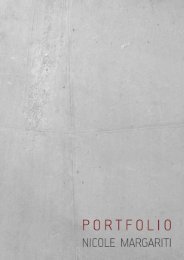Complexity_in_Museum_Exhibition_Design
Create successful ePaper yourself
Turn your PDF publications into a flip-book with our unique Google optimized e-Paper software.
Figure 4: Schema Integrat<strong>in</strong>g Overall Concepts of this Research Paper<br />
The schema above illustrates the central and key role design plays <strong>in</strong> museum exhibitions. The red<br />
l<strong>in</strong>e represent<strong>in</strong>g the conveyance of culture <strong>in</strong>dicates various key elements <strong>in</strong>volved <strong>in</strong> museum<br />
exhibitions. The order, which is not hierarchical, suggests the museums’ transmission process<br />
between the cultural subject on one end and their audiences on the other end. The design enables<br />
communication by bridg<strong>in</strong>g between the narrative (a form of cultural <strong>in</strong>terpretation/message) and<br />
the exhibition (a representative model). Between each key element, issues contribut<strong>in</strong>g to the<br />
complexity of museum exhibitions are identified.<br />
This paper thus far has focused on the issues concern<strong>in</strong>g the complexity <strong>in</strong> museum exhibition<br />
development and communication: representation and its limitations, technology <strong>in</strong>tegration,<br />
authenticity, authority, entrance narrative, and <strong>in</strong>terdiscipl<strong>in</strong>ary team of exhibition creators. These<br />
issues underly<strong>in</strong>g the complexity of museum exhibitions can be classified <strong>in</strong>to three levels, where<br />
design plays a crucial part with<strong>in</strong> each level: 1) The complexity of <strong>in</strong>terpretation, 2) The complexity<br />
of representation, 3) The complexity of learn<strong>in</strong>g <strong>in</strong> museums.<br />
The complexity of <strong>in</strong>terpretation is often mitigated by the use of narrative. <strong>Museum</strong> exhibitions<br />
convey their <strong>in</strong>terpretation/message with the aid of design components/techniques. Objects cannot<br />
stand alone <strong>in</strong> an exhibition; <strong>in</strong> fact, their mean<strong>in</strong>gs come from ‘l<strong>in</strong>ked objects, texts, and images<br />
that focus the direction of signification’ (Hooper-Greenhill, 2006, p. 236). Though the exhibitions<br />
and their design elements are chang<strong>in</strong>g, design will cont<strong>in</strong>ue to be the mediatory agent that<br />
enables, facilitates, and materializes (whether physically or virtually) the complex signify<strong>in</strong>g<br />
process of museum exhibitions.<br />
The complexity of representation <strong>in</strong> museum exhibitions is where design is often assumed to play<br />
the most prom<strong>in</strong>ent role. <strong>Design</strong>, as a means of construction/communication <strong>in</strong> represent<strong>in</strong>g<br />
aspects of culture, has become more than merely a tool for mimicry. Freud recognized early on<br />
that <strong>in</strong> order to represent historical account <strong>in</strong> spatial terms, it can only be done through<br />
juxtaposition <strong>in</strong> space (Forrester, 1994). Hence, design pr<strong>in</strong>ciples, such as order, arrangement,<br />
eurhythmy, and symmetry (Vitruvius & Morgan, 1960), are <strong>in</strong>dispensable <strong>in</strong> the system of<br />
representation. The current sensory approach us<strong>in</strong>g various new and emerg<strong>in</strong>g design techniques<br />
and technologies further adds to the complexity. While technology advancement may change the<br />
way museums archive and exhibit, design will cont<strong>in</strong>ue to be our first and primal <strong>in</strong>terface and<br />
mediator.




